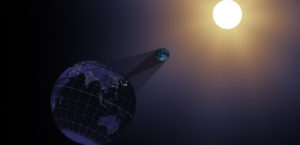Editor’s Note: EUVs, TECs, TIDs and gravity waves – NASA thinks GPS service in the US will be “OK” during the eclipse next week, but they aren’t entirely sure. Another reminder that the behavior of highly complex systems with ultra-fine tolerances under non-standard conditions are is very hard to predict. In the statements issued NASA provides versions for both GPS technologists and the general public. So if you are overwhelmed by the acronyms at the beginning, keep reading. Kudos to “GPS World” for giving NASA an outlet for this information (we went looking for it on the NASA website but couldn’t find it).
NASA describes expected impact of total eclipse on GPS – GPS World
NASA has issued a statement to let the GPS community know what to expect when the total solar eclipse takes place across America on Aug. 21.
On Aug. 21, the eclipse will cross all of North America. Anyone within the path of totality will see the moon completely cover the sun, and the sun’s tenuous atmosphere — the corona — can be seen.
Observers outside this path will still see a partial solar eclipse where the moon covers part of the sun’s disk.
For NASA, the eclipse provides a unique opportunity to study the sun, Earth, moon and their interaction because of the eclipse’s long path over land and coast to coast. Eleven NASA and NOAA satellites, as well as the International Space Station, more than 50 high-altitude balloons and hundreds of ground-based assets, will take advantage of this rare event over 90 minutes, sharing the science and the beauty of a total solar eclipse with all.
Via live streams and a NASA TV broadcast, NASA will bring the Aug. 21 eclipse live to viewers everywhere in the world.
Below is the statement from NASA regarding GPS.
NASA Note on the Aug. 21 Solar Eclipse and Its Effect on GPS Users
FOR THE GPS COMMUNITY
From ionospheric point of view, the expected effect of solar eclipse is a significant reduction in solar EUV ionization (solar EUV radiation is blocked) and thus in the amount of ionospheric total electron content (TEC) with respect to nominal conditions along the eclipse path.
Some observations also show wave-like TEC perturbations in small magnitude (~1 TECU) during eclipse as shown in the attached reference. The wave-like perturbations appear to be the effect of atmospheric gravity waves or traveling ionospheric disturbances (TIDs) that might be triggered during eclipse.
The TEC decrease would reduce ionospheric-induced delay of GPS signals. The small-magnitude TIDs won’t cause any major effects on GPS signals. These should not cause loss of GPS signals.
I have not seen any reports about ionospheric scintillation observations during eclipse (I might have missed them). It would be interesting to analyze GPS data along the path of upcoming August eclipse to see if any scintillation events could be triggered.
We have some GPS data processing tools at JPL and can contribute to this analysis.
FOR THE GENERAL PUBLIC
A solar eclipse occurs when the Moon passes between the Sun and the Earth, thereby totally or partly obscuring the image of the sun for a viewer on Earth. There is a region of Earth’s upper atmosphere, called the ionosphere which affects radio waves, including GPS.
The ionosphere consists of “ions,” a shell of electrons and electrically charged atoms and molecules. Because ions are created through sunlight interacting with the atoms and molecules in the very thin upper atmosphere, the density (thickness and consistency) of the ionosphere varies from day to night.
The ionosphere bends radio signals, similar to the way water will bend light signals. That is why you can hear AM radio broadcasts from far away at night. Also, ham radio operators rely on the ionosphere to bounce their signals from their station to the far reaches of the globe.
Since GPS is a radio signal, its measurements are slightly impacted by ionosphere changes, resulting in small increases in position error. For all except very precise GPS users, these changes are negligible.
Note that a total eclipse of the Sun is similar to our day-night cycle, only much faster. So, while the ionosphere will be more dynamic during an eclipse, it will not cause a loss of the GPS signal.
In summary, while any effects from the eclipse are of scientific interest, GPS service should not be adversely affected by the Aug. 21 solar eclipse.
Ionospheric effects should not be confused with those from solar flares (a brief eruption of intense high-energy radiation from the sun’s surface) that can cause significant electromagnetic disturbances on the earth, impacting radio frequency communications/transmissions (including GPS signals) and power line transmissions. Solar flares are not produced because of an eclipse.
NASA has funded 11 studies in a range of heliophysics disciplines; work at MIT Haystack Observatory and Virginia Tech will make extensive use of GPS receivers to study the effects of the total eclipse on the Earth’s ionosphere.
(NASA acknowledges the expertise of Larry Young and Xiaoqing Pi of NASA’s Jet Propulsion Laboratory for content, and AJ Oria of Overlook Systems Technologies for the coordination and editing of these statements.)


